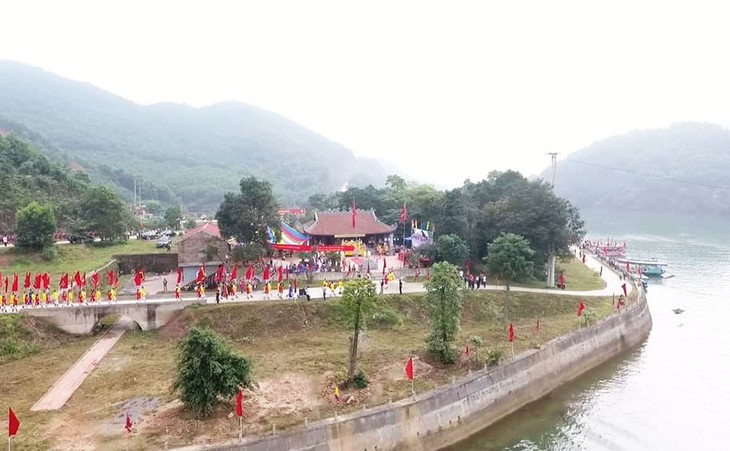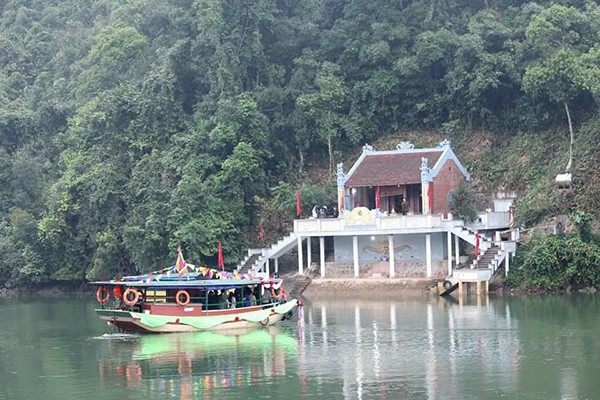(VOVWORLD) - There is no place other than Ba Che district, Quang Ninh province, where two temples face each other across a river. The Mieu Ong and Mieu Ba temples are historical evidence of the Vietnamese people’s conquering nature, expanding their territory to the north while defending their sovereignty against foreign invaders. The temples are venues for local religious ceremonies and pilgrimage destinations at the beginning of every lunar year.
The 80-kilometer Be Che River winds through villages along National Highway 18. At its estuary sit the Mieu Ong and Mieu Ba temples.
Mieu Ong worships General Le Ba Duc, who was instrumental in defending King Tran Nhan Tong and his father Tran Thanh Tong from the Yuan-Mongol invaders when they took refuge in the area in early 1285.
Hoang Minh Duc, chief manager of the Mieu Ong-Mieu Ba relic, said, “This was a strategic military location, where troops took shelter and got training. King retreated here, then went to Hai Phong and Thanh Hoa to fight back the invaders.”
Mieu Ong looks south-west. It was built on a 50-square-meter area, has brick walls surrounded by a lush green yard, and is tiled with a yin-yang roof, made of alternating rows of concave and convex tiles.
After the August Revolution of 1945, Mieu Ong was a venue for literacy classes and a children’s playground. In 2015, the temple was renovated and expanded to cover 500 square meters. It has three main halls and two side chambers. The tiled roof resembles layered lotus petals. The temple leans against a mountain and faces a river.
 Mieu Ong worships General Le Ba Duc. (Photo: baoquangninh.com.vn) Mieu Ong worships General Le Ba Duc. (Photo: baoquangninh.com.vn) |
On the opposite river bank stands Mieu Ba. Mieu Ba commemorates Mau Thuong Ngan (Mother Goddess of the Forest), who, according to legend, is the daughter of Saint Tan Vien and Princess My Nuong– the daughter of the 18th Hung King. The Mother Goddess of the Forest taught the local people to grow rice and trees, create terraced rice fields, build homes, and treat diseases using medicinal herbs. Local people believe General Le Ba Duc and the Mother Goddess of the Forest will always bless and protect the 10 ethnic minority groups living in Ba Che district.
On the first day of the third lunar month, a festival is held at the Mieu Ong-Mieu Ba relic, featuring a water procession from the Ba Che river to Mieu Ong for a statue bathing ritual, a procession of the tutelary god’s votive table, an incense offering, a ritual release of fish into the Ba Che river, folk games, and a “chung” (square sticky rice) cake making competition.
Luc Mai Phuong, a Ba Che resident, told us, “On the 1st and 15th day of every lunar month and during festivals, this is a popular destination for people in Nam Son commune to come to pray for good health and good luck.”
The Mieu Ong-Mieu Ba site is gaining popularity. Visitors can take a boat along the Ba Che river to the Dong Rui mangrove forest, then cruise inside the forest for an hour to Long Vang, an island with a golden sand beach that stretches 22 hectares.
Le Vu Hang, a tourist from Hanoi, said, “This is the first time I’ve been here, a peaceful place populated by the Kinh majority and several ethnic groups. I’m drawn to the natural scenery. I learned about the Mieu Ong-Mieu Ba relic through the media. Now I can see the temples with my own eyes.”
 Mieu Ba commemorates Mother Goddess of the Forest. (Photo: thethaovanhoa.vn) Mieu Ba commemorates Mother Goddess of the Forest. (Photo: thethaovanhoa.vn) |
Ha Ngoc Tung, chief of the Culture and Information Division of Ba Che district, said this area welcomes 10,000 visitors a year.
“The 700-year-old Mieu Ong-Mieu Ba relic is part of a rich religious and historical collection in Quang Ninh province. There is a tour connecting this relic with an ancient porcelain kiln, the Co Ngua river, the Dao ethnic cultural village, and the Da communal house,” according to Tung.
The Mieu Ong-Mieu Ba site was recognized as a national historical relic in late 2020.